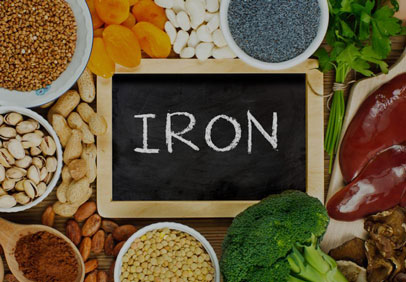It’s important to include iron-rich foods in your healthy eating plan, so you can perform well at the gym or on a mission. Iron is a mineral that helps produce hemoglobin, which carries oxygen throughout your body. Iron deficiency happens when there’s not enough iron in your body. Iron-deficiency anemia occurs when your iron deficiency is severe enough to reduce red blood cell and hemoglobin production, leading to fatigue and decreased endurance performance. Some early warning signs include shortness of breath, dizziness, and light-headedness during exercise. The good news is you can eat a variety of iron-rich foods to maintain healthy iron levels and optimal performance.
Female Service Members with physically active positions are at high risk of iron deficiency associated with training. In addition, women who start a more rigorous training program than they’re used to, such as Basic Training, are particularly at risk of iron deficiency and iron-deficiency anemia, with incidence increasing from the start of Basic Training to the end. You also might be at risk of iron deficiency and iron-deficiency anemia if you relocate from sea level to altitude. Iron levels initially drop during this time because your body is busy making more red blood cells to maintain oxygen levels as you adapt to higher altitude.
How to get enough iron
It’s important to take action to prevent iron deficiency. To ensure your diet is adequate, aim for 18 mg/day of iron. If you’re vegetarian or physically active, then you’ll also need an additional 10% or approximately 20 mg/day.
There are two forms of iron: heme and non-heme. Heme iron is found in animal products, including red meat, chicken, turkey, and fish. Non-heme iron is found in leafy greens, beans, lentils, whole grains, and other plant sources. Your body better absorbs heme iron than non-heme iron. However, the majority of the iron in your diet is from non-heme iron because you need those plant sources for optimal health. The table below can help you find foods with heme and non-heme sources of iron.
|
Heme Iron Sources |
Non-heme Iron Sources |
|
Red meat (such as beef and pork) |
Spinach |
|
Chicken |
Nuts and seeds |
|
Turkey |
Beans, legumes, and chickpeas |
|
Tuna and other fish |
Dried fruit |
|
Clams, mussels, and oysters |
Fortified cereal and oatmeal |
|
Sardines |
Whole grains |
|
Liver |
Tofu |
Iron enhancers
Vitamin C helps your body absorb more iron from the foods you eat, so pair your iron-rich foods with any of the foods below.
|
Oranges (and orange juice) |
Grapefruit (and grapefruit juice) |
Berries |
|
Cantaloupe |
Pineapple |
Kiwi fruit |
|
Bell peppers |
Tomatoes (and tomato juice) |
Cauliflower |
|
Sweet potatoes |
|
|
Putting it all together
Choosemyplate.gov has a 7-day menu that shows how easy it is to eat a balanced diet and meet your iron needs with some planning. Be creative and tweak your meals with some of your favorite foods from the sources listed above.
If you experience symptoms of iron deficiency, or if you’re concerned about your iron intake, talk to your doctor. In some cases, an iron supplement might be recommended, but it shouldn’t replace the iron you eat from food. And keep in mind your doctor can help monitor your dosage, side effects, or other health concerns. You also can talk to a registered dietitian for a nutrition plan that helps meet your personal iron needs through food.
Debrief
Female Service Members with physically active positions are at high risk of iron deficiency and iron-deficiency anemia, which can lead to decreased performance. Learn how to be proactive by eating iron-rich foods to add some pep in your step and boost your performance.
